
Royal Delta Club,
presumably in townhomes
on the left. 1879 map from Library of Congress |
Joint Chapter Rooms and Royal Delta Club, 1887-1888
(Site only)
"In the fall of 1887 a joint committee of Upsilon [City College] and Omega [Columbia], having reached the decision that a clubhouse was necessary to the continuance and success of the fraternity in New York, engaged rooms at No. 13 West 42nd Street. The expense being heavy, they invited as many recent graduates as could be found to share it with them. A goodly number gathered one night at the home of J. W. White, College of the City of New York '85, and adopting a simple scheme of organization, formed the Royal Delta Club for purposes purely social. They agreed to meet every second Tuesday, and as the news spread, more and more graduates began to attend those fortnightly smokers at the chapter rooms. By January, 1888, there were at least thirty members, and the more ambitious of them proposed the idea of a real club-house."
--The History of Phi Gamma Delta, Tomos Beta
Number 13 was probably among the townhomes depicted to the left. Across 42nd Street was the Croton Reservoir (1842-1900), later dismantled for the construction of the New York Public Library. Next door at the intersection of 42nd and 5th Avenue was the Hotel Bristol.
13 West 42nd Street
|

The Delta Club
(The Phi Gamma Delta,
May 1888) |
Site of the Delta Club, 1888-1890
On April 20, 1888 the Delta Club moved into this leased home, former home of the Columbia College Club. The Columbia and CCNY chapters also held meetings here.
When the Columbia Chapter moved in 1890, the Delta Club closed.
The site was located on the south side of 49th Street between Madison and Park Avenue, directly across from Columbia College. The College became Columbia University in 1896 and relocated uptown to its current campus in 1897.
68 East 49th Street
|
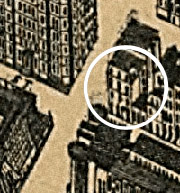
503 Fifth Avenue;
across the street is the Hotel Bristol. 1879 map from Library of Congress |
Phi Gamma Delta Club, c. 1894
"The club idea, however, was too good to die . . . and in May, 1894, the Phi Gamma Delta Club was organized at 503 Fifth Avenue, at the northeast corner of Fifth Avenue and 42nd Street. The object of this club, too, was at first purely social. No regular meetings were held, business being handled by a governing board of twelve . . . . An article in the October, 1894, magazine invites callers to drop in on Thursday evenings when they will be most likely to find a congenial throng discussing a game of billiards, cards, or otherwise passing an agreeable evening. . . . By 1896 membership had increased to seventy . . . . Here the fate of the original Delta Club repeats itself in the disintegration of the first Phi Gamma Delta Club of New York. Smokers were given spasmodically and finally were discontinued."
--The History of Phi Gamma Delta, Tomos Beta
503 Fifth Avenue at 42nd Street, cattycorner from New York Public Library
|
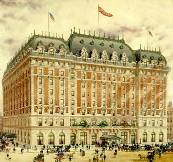
Hotel Astor,
from the Museum of
the City of New York
|
Hotel Astor (site only)
Built in 1904, and site of Fiji graduate gatherings or "jamborees" from 1905 to 1907. The Phi Gamma Delta Club was formed here in the summer of 1907. The 69th Ekklesia convened here in December, 1917.
In 1967 the hotel was demolished; an office tower now occupies the site.
At Times Square, 1515 Broadway (on the west side of Seventh Avenue between 44th and 45th Streets). Shown in bottom left hand corner of map from The Phi Gamma Delta magazine.
|

The Royalton,
from a postcard |
The Royalton
Phi Gamma Delta Club rooms 1907-1909 and 1921-1928
The Phi Gamma Delta Club had its first headquarters at the Royalton, a "bachelor hotel," from November 1, 1907 until the construction of the clubhouse at 34 West 44th in 1909. The Club returned to the Royalton on December 6, 1921 after the clubhouse's lease expired. There it remained until the 1928 completion of the new clubhouse on West 56th.
The Royalton today is an upscale hotel, remodeled in a modernist style.
44 West 44th Street, between 5th and 6th avenues
|
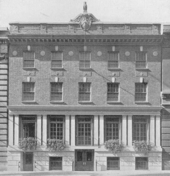
New York Club,
from Tomos Beta
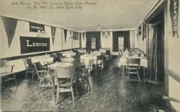
West 44th, Grill Room
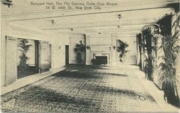
West 44th, Banquet Room |
Phi Gamma Delta Club, 1909-1921 (site only)
After the turn of the century many organizations, including college alumni groups and fraternities, built clubhouses in New York. These were patterned to a degree after London's gentlemen's clubs.
In 1908 the Phi Gamma Delta Club signed a lease on a lot owned by the New York City Bar Association; by February 1909 they had built the new clubhouse as designed by Washington Hull (Columbia '87). It provided lodging, dining, and entertainment for residents and visitors alike, especially servicemen en route to or from the European theater during World War One.
When the land lease expired at the end of 1921, the Bar Association declined to renew it. The Club moved back to the Royalton. The building was torn down in 1924 and replaced with an office tower.
34 West 44th Street
|
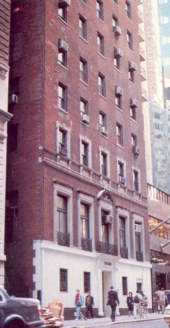
Former New York Club
circa 1990,
from The Phi Gamma Delta |
Former Phi Gamma Delta Club, 1928-1962
The lot at 106 West 56th Street was purchased for a new Phi Gamma Delta Club in the fall of 1923. The cornerstone was laid on November 3, 1927, and the Club was dedicated February 16, 1928. The fifty by ninety foot, nine-story building featured 106 hotel rooms, along with a dining room, two lounges, a men's bar, exercise facilities, and a library.
The Club had an immense emotional and social role for the Fraternity. However, the Depression brought financial difficulties, requiring appropriations from the Fraternity. In 1950 the Fraternity assumed ownership of the Club and sought to pay off the mortgage and establish profitability; but by 1961 the building required a prohibitively expensive overhaul. In a much-lamented decision the Fraternity sold the Club on June 29th, 1962.
Since then it has served as offices for America, a weekly Jesuit magazine. The building retains a limestone carving of the coat-of-arms above the second story window.
106 West 56th Street, between Sixth and Seventh Avenues.
Map from The Phi Gamma Delta magazine.
|
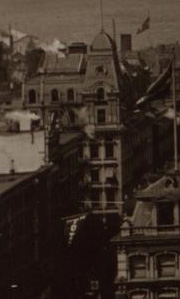
Park Place #30 c.1897 |
First Central Office, 1898-1899
By December, 1898, the Fraternity's first official central office was opened by the Archon Secretary at Park Place, for the cost of $150 a year. Archon Secretary William E. Gard (Yale 1877, Maryland 1879) told the 1899 Ekklesia,
"It is well adapted for its purpose, being in the very heart of the downtown business center, and within one block of the post-office. It is on the sixth floor, reached by an elevator, and is supplied with all the conveniences, as running water, steam heat, gas and electric light, and janitor service. In this room were placed all the working essentials of a business office: a typewriting machine, desk and mimeograph . . . letter boxes and shelving belonging to the archives . . . . The office has been kept open in the mornings for an entire year."
Like most Archon Secretaries after him, he chose the building because the offices of his company, Meriden Bronze Co., were also located there.
Gard hired Joe Walker McSpadden (Tennessee 1897) to manage the office. Later, The Phi Gamma Delta magazine said "The office was entirely inadequate for the needs of the fraternity, beside being in an old building with no pretentions [sic] of being fireproof."
The origin and fate of the building are unclear, but in the 1950s Dun and Bradstreet razed the block to build its headquarters, which is still extant.
Southeast corner of Church and Park Place (originally 30 Park Place)
|
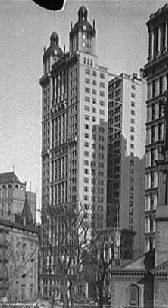
Park Row |
Second Central Office, 1899-____
"Immediately after the Dayton Convention [October, 1899] new quarters were secured in the splendid new thirty-story Park Row Building. The office room is conveniently located, is fresh and prettily furnished and best of all is absolutely fireproof."
So reported The Phi Gamma Delta magazine in December, 1899. Archon Secretary William E. Gard (Yale 1877, Maryland 1879) moved the central office a short distance to Room No. 1231, Park Row Building. He reported the structure as "the largest office building in the world. The office is very centrally located, being directly opposite the post office building." The first brother paid to manage the office at this location was G. Foster Smith (Minnesota 1898).
Completed in 1899, the Park Row building was designated a historic landmark in 1999. It still houses offices today.
15 Park Row (originally 21 Park Row)
|
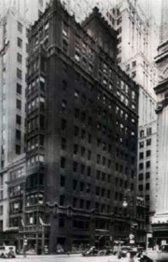 |
Law Offices of Horace Brightman;
Fraternity Central Office, 1917-1922
After the election of Horace I. Brightman (Columbia 1892) as Archon Secretary at the 1917 Ekklesia, the central office was moved from Pittsburgh to New York City. It remained here until George F. Snyder's election as Secretary in 1921, when the office was moved to Washington, DC.
Brightman served as Archon President from 1923 to 1934, the longest term ever.
Built in 1900 as an office building, it is now the upscale Library Hotel. www.libraryhotel.com
299 Madison Avenue, at 41st Street
|
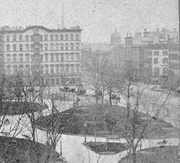
Northeast corner of Union Square, from the Library of Congress/New York Public Library
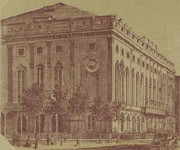
Academy of Music,
from New York Public Library |
Upsilon Chapter Hall (site only); Academy of Music (site only) 1873 Convention
Our chapter at the College of the City of New York hosted the twenty-fifth anniversary convention. Sessions met in the chapter's rented rooms April 29 to May 1, 1873. While we know the intersection at the northeast corner of Union Square, we do not know in which building the chapter hall was located. On the NW corner was the Everett House hotel; to the SE was the Westmoreland Apartment House. A small townhouse took the NE corner. All three were torn down between 1908 and 1929 for larger buildings.
Public exercises convened at the New York Academy of Music. The Academy opened in 1854, burned in 1866, was restored, and was razed in 1925.
Incidentally, Omega Chapter announced itself to Columbia College (now University) at an event held at the Academy in January, 1869. They had operated as a "sub rosa" chapter for just over two years.
Upsilon Chapter Rooms, Park Ave. South (formerly 4th Ave.) and East 17th St.
New York Academy of Music, NE corner 14th St. and Irving Place
|
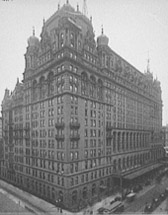
Original Waldorf Astoria |
Waldorf Astoria Hotel (site only)
1908 Ekklesia
The famous Waldorf Astoria Hotel hosted the 60th Ekklesia in June and July, 1908.
Originally it was two separate hotels-- the thirteen-story Waldorf built in 1893, and the seventeen-story Astoria, built 1897.
In 1929, the hotel relocated to make way for the construction of the Empire State Building.
Fifth Avenue between 33rd and 34th Streets
|
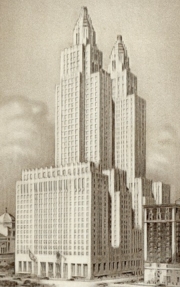
Waldorf Astoria,
from postcard |
Warldorf Astoria Hotel
1940 Ekklesia
Built in 1931, the second Waldorf Astoria stands 47 stories and occupies an entire city block. It was the largest hotel in the world at the time of its construction.
The Waldorf Astoria was site of the 92nd Ekklesia in June, 1940. It has also been the location of many Xi Graduate Chapter events. The National Interfraternity Conference held its annual meetings here in 1945, 1952, 1956 and 1959.
Hotel description and photos; www.waldorfastoria.com
301 Park Avenue, between 49th & 50th Streets
|
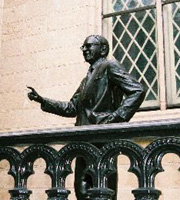
Statue of Norman Vincent Peale |
Norman Vincent Peale Statue
Marble Collegiate Church
Norman Vincent Peale (Ohio Wesleyan 1920) was pastor of Marble Collegiate for 52 years. He also gained international fame as author of bestselling motivational books such as "The Power of Postive Thinking" and editor of Guideposts magazine.
At Ohio Wesleyan, Peale roomed with Cecil "Scoop" Wilkinson, who later was editor and executive secretary of Phi Gamma Delta.
The church was completed in 1854. The statue, donated by the Peale family, is just outside the church. Another copy is in Pawling, New York.
Corner of 5th Avenue and 29th Street
|